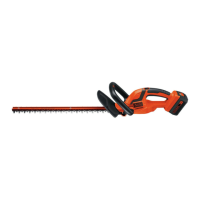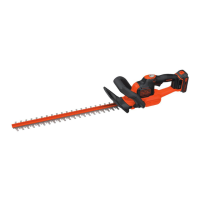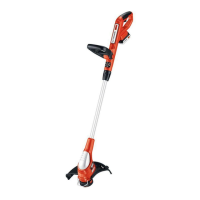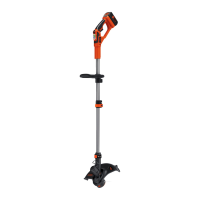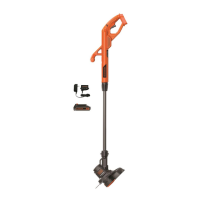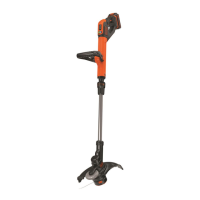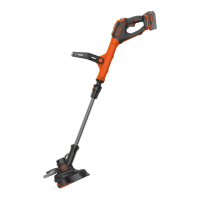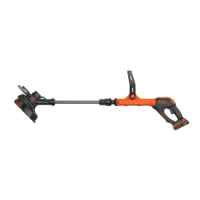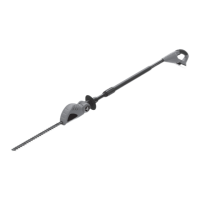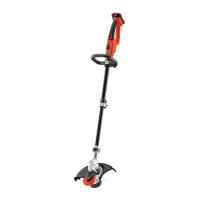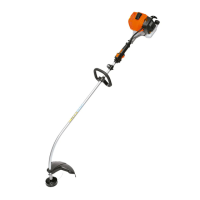7
ENGLISH
the trigger switch locked on. Never tape the trigger
switch in the ONposition.
• Do not incinerate the battery pack even if it is
severely damaged or is completely worn out. The
battery pack can explode in a fire. Toxic fumes and
materials are created when lithium‑ion battery packs
areburned.
• If battery contents come into contact with the skin,
immediately wash area with mild soap and water. If
battery liquid gets into the eye, rinse water over the open
eye for 15minutes or until irritation ceases. If medical
attention is needed, the battery electrolyte is composed of a
mixture of liquid organic carbonates and lithiumsalts.
• Contents of opened battery cells may cause
respiratory irritation. Provide fresh air. If symptoms
persist, seek medicalattention.
• Battery liquid may be flammable if exposed to spark
orflame.
• Never attempt to open the battery pack for any
reason. If the battery pack case is cracked or
damaged, do not insert into the charger. Do not crush,
drop or damage the battery pack. Do not use a battery
pack or charger that has received a sharp blow, been
dropped, run over or damaged in any way (e.g., pierced
with a nail, hit with a hammer, stepped on). Damaged
battery packs should be returned to the service center
forrecycling.
Storage Recommendations
The best storage place is one that is cool and dry, away
from direct sunlight and excess heat or cold. Store the fully
charged battery pack out of thecharger.
Battery Pack Cleaning Instructions
Dirt and grease may be removed from the exterior of the
battery using a cloth or soft non‑metallic brush. Do not use
water or any cleaningsolutions.
Transportation
WARNING: Fire hazard. Do not
store, carry, or transport the battery pack so
that metal objects can contact exposed battery
terminals. For example, do not place the battery
pack in aprons, pockets, tool boxes, product kit boxes,
drawers, etc., with loose nails, screws, keys, coins, hand
tools, etc. When transporting individual battery packs,
make sure that the battery terminals are protected and
well insulated from materials that could contact them
and cause a short circuit. NOTE: Li‑ion battery packs
should not be put in checked baggage on airplanes
and must be properly protected from short circuits if
they are in carry‑onbaggage.
READ ALL INSTRUCTIONS
Important Safety Instructions for All
Battery Packs
WARNING: Read all safety
warnings, instructions, and cautionary markings
for the battery pack, charger and product. Failure
to follow the warnings and instructions may
result in electric shock, fire and/or seriousinjury.
• Do not charge or use the battery pack in explosive
atmospheres, such as in the presence of flammable
liquids, gases or dust. Inserting or removing the battery
pack from the charger may ignite the dust orfumes.
• NEVER force the battery pack into the charger. DO
NOT modify the battery pack in any way to fit into a
non‑compatible charger as battery pack may rupture
causing serious personal injury.
• Charge the battery packs only in
BLACK+DECKERchargers.
• Consult the chart at the end of this manual for
compatible battery packs and chargers.
• DO NOT splash or immerse in water or otherliquids.
• DO NOT allow water or any liquid to enter batterypack.
• Do not store or use the tool and battery pack in
locations where the temperature may reach or
exceed 104°F (40°C) (such as outside sheds or metal
buildings in summer). For best life store battery packs in
a cool, drylocation.
NOTE: Do not store the battery packs in a tool with
BATTERIES AND CHARGERS
The battery pack is not fully charged out of the carton.
Before using the battery pack and charger, read the
safety instructions below and then follow charging
proceduresoutlined. When ordering replacement battery
packs, be sure to include the catalog number andvoltage.
The label on your tool may include the following symbols. The
symbols and their definitions are asfollows:
BPM .................... beats per minute
V ......................... volts
min ..................... minutes
j
or DC ............direct current
…/min ..............per minute
RPM .................... revolutions per
minute
A ......................... amperes
Hz .......................hertz
W ........................watts
Wh ......................watt hours
n
o
.......................no load speed
n .........................rated speed
c
.....................safety alert symbol
h
..................... wear respiratory
protection
f
..................... wear eye protection
i
..................... Class II Construction
(double insulated)
g
..................... wear hearing
protection
a
..................... read all
documentation
..................... do not expose to
rain
n
..................... avoid staring at
light
l
or AC............alternating current
Ah ....................... amp hours
CSPM .................. cut strokes per
minute
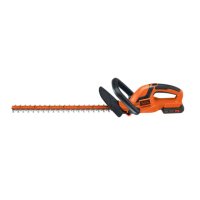
